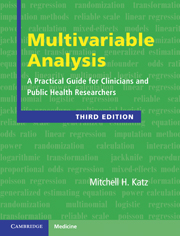Book contents
- Frontmatter
- Contents
- Preface
- 1 Introduction
- 2 Common uses of multivariable models
- 3 Outcome variables in multivariable analysis
- 4 Independent variables in multivariable analysis
- 5 Relationship of independent variables to one another
- 6 Setting up a multivariable analysis
- 7 Performing the analysis
- 8 Interpreting the results
- 9 Delving deeper: Checking the underlying assumptions of the analysis
- 10 Propensity scores
- 11 Correlated observations
- 12 Validation of models
- 13 Special topics
- 14 Publishing your study
- 15 Summary: Steps for constructing a multivariable model
- Index
- References
8 - Interpreting the results
Published online by Cambridge University Press: 01 April 2011
- Frontmatter
- Contents
- Preface
- 1 Introduction
- 2 Common uses of multivariable models
- 3 Outcome variables in multivariable analysis
- 4 Independent variables in multivariable analysis
- 5 Relationship of independent variables to one another
- 6 Setting up a multivariable analysis
- 7 Performing the analysis
- 8 Interpreting the results
- 9 Delving deeper: Checking the underlying assumptions of the analysis
- 10 Propensity scores
- 11 Correlated observations
- 12 Validation of models
- 13 Special topics
- 14 Publishing your study
- 15 Summary: Steps for constructing a multivariable model
- Index
- References
Summary
What information will my multivariable analysis produce?
Multivariable techniques produce two major kinds of information: Information about how well the model (all the independent variables together) fit the data and information about the relationship of each of the independent variables to the outcome variable (with adjustment for all other independent variables in the analysis). In this chapter, we will review information that is routinely output from multivariable software programs. In the next chapter we will delve deeper into how well the assumptions of the models are fulfilled and how to improve the fit of the models by looking at supplementary techniques that you may request.
How do I assess how well my model fits the data?
Although there is some overlap, the methods for determining how well a model accounts for the outcome differ by type of multivariable analysis (Table 8.1). The methods for each model are discussed below.
A Multiple linear regression
We start the assessment of a multiple linear regression model by testing whether the independent variables predict the outcome better than assuming that everyone in the study had the mean value for the outcome. If knowing the values of the independent variables improves the fit more than would be expected by chance, then the value of F will be large. A large F value for a given sample size and a given number of variables in the model (which determines the degrees of freedom) will result in a small P value.
Information
- Type
- Chapter
- Information
- Multivariable AnalysisA Practical Guide for Clinicians and Public Health Researchers, pp. 140 - 161Publisher: Cambridge University PressPrint publication year: 2011
References
Accessibility standard: Unknown
Why this information is here
This section outlines the accessibility features of this content - including support for screen readers, full keyboard navigation and high-contrast display options. This may not be relevant for you.Accessibility Information
- 3
- Cited by
